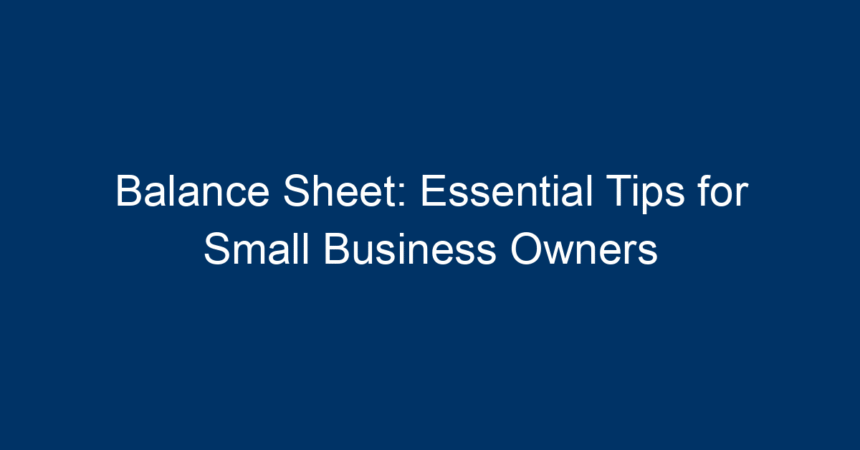In the world of small business, having a solid grasp of your finances is paramount for success. Among the essential financial statements, the balance sheet stands out as a critical tool for small business owners. Not only does it provide a snapshot of your business’s financial health, but it also helps you make informed decisions about the future. In this article, we’ll explore what a balance sheet is, its components, and essential tips for small business owners to effectively utilize this vital document.
What is a Balance Sheet?
A balance sheet is a financial statement that provides an overview of a company’s assets, liabilities, and equity at a specific point in time. It follows the accounting equation:
Assets = Liabilities + Equity
This equation ensures that your books are balanced, reflecting the financial position of your business accurately. The balance sheet serves as a critical tool for stakeholders, including investors, creditors, and management, to evaluate the company’s financial stability and liquidity.
Key Components of a Balance Sheet
Understanding the components of a balance sheet is essential for small business owners. Here’s how to break it down:
1. Assets
Assets are resources owned by your business that have economic value. They can be classified into two categories:
-
Current Assets: These are assets expected to be converted into cash or used within a year. Examples include cash, accounts receivable, inventory, and short-term investments.
- Non-Current Assets: These assets have a longer lifespan, typically lasting more than a year. Examples include property, equipment, and intangible assets like patents.
2. Liabilities
Liabilities represent your business’s financial obligations. Similar to assets, they are divided into:
-
Current Liabilities: These are obligations that need to be settled within one year, such as accounts payable, short-term loans, and accrued expenses.
- Long-Term Liabilities: These include debts and obligations that extend beyond one year, such as mortgages and long-term loans.
3. Equity
Equity represents the ownership value in your business after subtracting liabilities from assets. It includes the owners’ initial investments and retained earnings, which are profits reinvested in the business.
Why is a Balance Sheet Important for Small Business Owners?
Understanding the importance of a balance sheet can empower small business owners to make better financial decisions.
1. Financial Health Assessment
A balance sheet provides a clear picture of your company’s financial health. It allows you to see if your assets cover your liabilities, indicating your business’s ability to pay off debts. Positive equity suggests that your business is thriving.
2. Investment and Financing Decisions
When seeking investment or applying for loans, lenders and investors will scrutinize your balance sheet. A solid balance sheet demonstrates fiscal responsibility and can lead to better financing options.
3. Performance Tracking
By regularly reviewing your balance sheet, you can track the progression of your business over time. This will help you spot trends, prepare for future growth, and identify potential issues before they escalate.
4. Strategic Planning
A balance sheet aids in strategic planning by highlighting areas that need improvement. For example, if you have high liabilities compared to assets, it may signal the need to reduce debt or increase sales.
Essential Tips for Small Business Owners to Effectively Use Their Balance Sheets
With a clearer understanding of what a balance sheet is and why it’s important, let’s delve into essential tips for small business owners to effectively utilize this financial tool.
1. Keep Your Balance Sheet Updated
Ensure your balance sheet reflects the most recent financial transactions. Regular updates help you maintain an accurate picture of your financial status, aiding in timely decision-making.
2. Utilize Accounting Software
Consider using accounting software to automate balance sheet calculations and updates. Many tools offer built-in templates, making it easier to manage assets, liabilities, and equity.
3. Analyze Ratios
Utilizing financial ratios derived from your balance sheet can provide insights into your business’s performance. Important ratios include:
-
Current Ratio: Current Assets / Current Liabilities. This assesses your ability to meet short-term obligations.
- Debt-to-Equity Ratio: Total Liabilities / Total Equity. This measures your company’s leverage and financial risk.
4. Collaborate with Financial Advisors
Work with accountants or financial advisors who can provide expert advice on interpreting your balance sheet. They can help identify trends and provide guidance on areas for improvement.
5. Conduct Regular Reviews
Schedule regular reviews of your balance sheet—monthly, quarterly, or annually. Regular assessments allow you to detect issues and adjust your strategy accordingly.
6. Compare Against Industry Standards
Benchmark your balance sheet metrics against industry standards. Understanding how you stack up against competitors can help identify performance gaps and inspire improvements.
7. Prepare for Growth
Use your balance sheet to support growth plans. It will help you identify the assets needed and assess whether you have enough equity to fund expansion without over-leveraging your operations.
Common Mistakes to Avoid
While managing your balance sheet, be cautious of common pitfalls. Here are a few to avoid:
1. Neglecting Record Keeping
Failing to keep accurate and detailed records can lead to discrepancies in your balance sheet. Consistent bookkeeping is foundational to an accurate balance sheet.
2. Misclassifying Assets and Liabilities
Ensure that assets and liabilities are classified correctly. Misclassifications can distort your financial picture and lead to flawed decision-making.
3. Overlooking Depreciation
Not accounting for asset depreciation can make your balance sheet misleading. Ensure you include depreciation for fixed assets to reflect their current value accurately.
Conclusion: Take Action with Your Balance Sheet
As a small business owner, having a robust understanding of your balance sheet is crucial for navigating the financial landscape. By utilizing this financial statement effectively, you can assess your company’s health, make informed decisions, and plan strategically for the future.
Incorporating the tips discussed—keeping your balance sheet updated, utilizing accounting software, analyzing financial ratios, and collaborating with experts—will help ensure that you are making the most of this vital tool. Remember, the balance sheet is more than just numbers; it’s a roadmap guiding your business toward sustainable success. Take the time to understand it fully, and your business will reap the benefits.
Act now—review your balance sheet today and start leveraging this essential financial document to set your small business on a path toward growth and stability!




